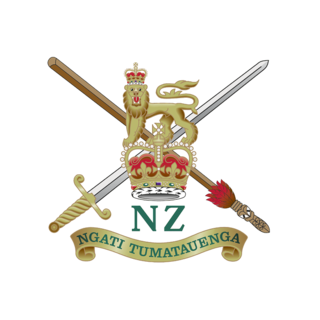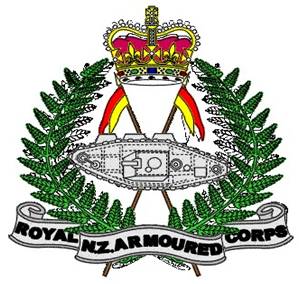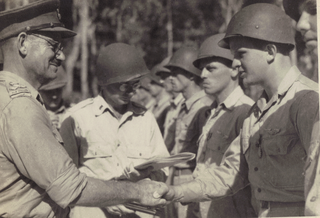
The New Zealand Army is the land component of the New Zealand Defence Force and comprises around 4,659 Regular Force personnel and 2,122 Reserve Force personnel. Formerly the New Zealand Military Forces, the current name was adopted by the New Zealand Army Act 1950. The New Zealand Army traces its history from settler militia raised in 1845.

The Royal Regiment of New Zealand Artillery is the artillery regiment of the New Zealand Army. It is effectively a military administrative corps, and can comprise multiple component regiments. This nomenclature stems from its heritage as an offshoot of the British Army's Royal Artillery. In its current form it was founded in 1947 with the amalgamation of the regular and volunteer corps of artillery in New Zealand. In 1958 in recognition of services rendered it was given the title the Royal Regiment of New Zealand Artillery.

The Waikato Mounted Rifles (WMR) is the New Zealand Army's only Territorial Force squadron of the Royal New Zealand Armoured Corps (RNZAC). The Squadron's origins can be traced back to 1869 when the first mounted unit was raised in the Waikato. Today the Squadron is part of Queen Alexandra's Mounted Rifles (QAMR) where it forms the regiment's reserve squadron. WMR's role is mounted reconnaissance and surveillance.

The Royal New Zealand Armoured Corps (RNZAC) is the overall umbrella grouping of Regular Force and Territorial Force units equipped with armoured vehicles in the New Zealand Army. The corps was formed in 1942 as the New Zealand Armoured Corps, before being given the Royal prefix in 1947. The RNZAC is second in seniority of corps within the New Zealand Army.

The 3rd New Zealand Division was a division of the New Zealand Military Forces. Formed in 1942, it saw action against the Japanese in the Pacific Ocean Areas during the Second World War. The division saw action in the Solomon Islands campaign during 1943–1944, during which it undertook landings on Vella Lavella, the Treasury Islands and the Green Islands. Due to manpower shortages, for most of its existence the division consisted of only two infantry brigades in addition to support personnel, with its third brigade being disbanded shortly after formation. In 1944, manpower shortages in the New Zealand economy became acute led to the disbandment of the division. The majority of its manpower was returned to civilian employment, although around 4,000 men were sent to Italy to reinforce the 2nd Division, seeing further action before the end of the war in May 1945.
The 5th Division, New Zealand Military Forces, was raised in the Southern Military District during the Second World War. It consisted of the 3rd and 10th Brigades and the 11th Brigade Group. It was disbanded after the danger of invasion from Japan receded. It appears to have been raised on 1 November 1941, and disbanded on 1 April 1944.

The 8th Brigade was a formation of the New Zealand Military Forces, which served during the Second World War as part of the 2nd New Zealand Expeditionary Force. Eventually forming part of the 3rd Division, the brigade served in the Pacific Ocean theatre of the war. Raised in late 1940, initially the brigade was employed on garrison duties on Fiji before returning to New Zealand in mid-1942. In December 1942, it was sent to New Caledonia where they remained until early September 1943, when they moved to Guadalcanal to prepare for operations in the Solomon Islands. The brigade's only combat operation of the war came in October–November 1943, when it captured the Treasury Islands. It was disbanded in late 1944 due to manpower shortages in the New Zealand economy.
The 1st Brigade is currently the largest unit of the New Zealand Army, and contains most of the army's deployable units. The brigade was formed on 13 December 2011 by amalgamating the 2nd Land Force Group and 3rd Land Force Group. Its establishment formed part of the 'Army 2015' package of reforms.

Brigadier General Sir Herbert Ernest Hart, was an officer in the New Zealand Military Forces who served during the Second Boer War and the First World War. He later served as the Administrator of Western Samoa and worked for the Imperial War Graves Commission.
The 1st Division was one of three New Zealand Army home defence divisions formed during World War II. The unit was established on 1 November 1941 and was responsible for protecting the northern region of New Zealand's North Island from invasion. The 1st Division was placed on alert during the early months of the Pacific War, but no threat developed. The division was greatly reduced in size during 1943 and was disbanded on 1 April 1944.
The 2nd Infantry Brigade was a formation of the New Zealand Military Forces raised for service abroad with the New Zealand Expeditionary Force during the First World War. As part of the New Zealand Division, it participated in several major battles on the Western Front from 1916 to 1918 before being disbanded in 1919. There was also a 2nd Infantry Brigade in the New Zealand Territorial Force that existed from 1924 to 1964.
The 1st New Zealand Army Tank Brigade was an armoured unit of the New Zealand Army during World War II. The brigade was formed in New Zealand during 1941 to provide the 2nd New Zealand Division with armoured support in North Africa. The outbreak of the Pacific War led to it being retained in New Zealand. The 1st Army Tank Brigade was disbanded in 1942, with most of its personnel being used to establish the 4th New Zealand Armoured Brigade in Egypt.
The 10th Infantry Brigade was a brigade of the New Zealand Military Forces formed on two separate occasions during the Second World War. The brigade was first formed as part of the 2nd New Zealand Division, just prior to the Battle of Crete. It consisted of a variety of New Zealand artillery and support units operating as Infantry, as well as two Greek Infantry regiments. The 10th Brigade was absorbed by 4th Brigade part way through the battle. The 10th Brigade was formed for the second time in New Zealand as a territorial force formation in November 1941 and became part of the 5th Division. By 1944 the threat of Japanese invasion was perceived to be minimal and the 10th Brigade was disbanded.

The Taranaki Regiment was a territorial infantry regiment of the New Zealand Military Forces. The regiment traced its origins to the Taranaki Volunteer Rifle Company, a volunteer corps formed in 1858 and which saw service in the New Zealand Wars. The volunteer corps also provided men to the New Zealand contingents sent to South Africa during the Second Boer War and in 1911 became the 11th Regiment . During the First World War, the regiment provided a company to each of the battalions of the Wellington Infantry Regiment and saw combat at Galipolli and on the Western Front. After the war the regiment was renamed the Taranaki Regiment and remained in New Zealand for home defense during the Second World War. Men from the regiment, however, served with the 19th, 22nd, 25th and 36th Battalions of the Second New Zealand Expeditionary Force. In 1948, the Taranaki Regiment was amalgamated with the Wellington West Coast Regiment and became the Wellington West Coast and Taranaki Regiment.

The Wellington Regiment was a territorial infantry regiment of the New Zealand Army. The regiment traced its origins to the Wellington Veteran Volunteer Corps, a volunteer corps formed in 1867 and which would later amalgamate with other volunteer corps to form the 5th (Wellington) Regiment in 1911. During the First World War, the regiment was first sent to capture German Samoa in August 1914 and was later affiliated with the New Zealand Rifle Brigade which saw combat on the Western Front. After the war, the regiment was renamed the Wellington Regiment and remained in New Zealand for home defence during the Second World War. Men from the regiment, however, served with the 19th, 22nd, 25th and 36th Battalions of the Second New Zealand Expeditionary Force. In 1964, the Wellington Regiment was amalgamated with the Hawke's Bay Regiment to become 7th Battalion, Royal New Zealand Infantry Regiment.

The 2nd Māori Battalion was a territorial battalion of the New Zealand Military Forces during the second world war. The battalion was formed in February 1942 as the 3rd battalion, North Auckland Regiment by converting a battalion of the National Military Reserve. The 2nd Māori Battalion garrisoned fortress areas in Northland and also provided training for personnel who would be latter posted overseas with 28th (Māori) Battalion. It was disbanded in 1944 along with most other territorial units.

The Hawke's Bay Regiment was a territorial infantry regiment of the New Zealand Military Forces. The regiment traced its origins to the Napier Rifle Volunteer Rifles, a volunteer corps formed in 1863 and which would later amalgamate with other volunteer corps to form the 9th Regiment in 1911. During the First World War, the regiment provided a company to each of the battalions of the Wellington Infantry Regiment and saw combat at Galipolli and on the Western Front. After the war the regiment was renamed the Hawke's Bay Regiment and remained in New Zealand for home defense during the Second World War. Men from the regiment, however, served with the 19th, 22nd, 25th and 36th Battalions of the Second New Zealand Expeditionary Force. The regiment had a close relationship with the Ruahine Regiment, which was detached and reabsorbed by the Hawke's Bay regiment on two separate occasions. In 1964, the Hawkes Bay regiment was amalgamated with the Wellington Regiment and become the 7th Battalion, Royal New Zealand Infantry Regiment

The Ruahine Regiment was a Territorial Force Infantry Regiment of the New Zealand Military Forces. It was briefly raised in the 1910s and saw service in the First World War as part of the Wellington Infantry Regiment. It was formed for a second time during the second world war and was deployed overseas as part of the 3rd Division but never saw combat.

The New Zealand Scottish Regiment was a regiment of the New Zealand Army. It was formed in 1939 as an infantry regiment and raised two battalions during the Second World War. Although the 1st Battalion was sent overseas during the war as part of the 3rd Division, it never saw combat. The regiment was reformed in 1948 as a reconnaissance regiment of the Royal New Zealand Armoured Corps, but by the 1960s had been reduced to two independent squadrons. Various armoured vehicles were utilized by the regiment including Daimler Dingo Scout Cars, Daimler Armoured Cars, Ferret armoured cars and M113a1 armoured personnel carriers. The regiment was eventually disbanded in 2013.
The Wellington West Coast Regiment was a territorial infantry regiment of the New Zealand Military Forces. The regiment traced its origins to the Wanganui Rifle Volunteers, a volunteer corps formed in 1860. The volunteer corps provided men to the New Zealand contingents sent to South Africa during the Second Boer War and in 1911 became the 7th Regiment. During the First World War, the regiment provided a company to each of the battalions of the Wellington Infantry Regiment, which saw combat at Galipolli and on the Western Front. After the war the regiment was renamed the Wellington West Coast Regiment and remained in New Zealand for home defence during the Second World War. Men from the regiment, however, served with the 19th, 22nd, 25th and 36th Battalions of the Second New Zealand Expeditionary Force. In 1948, the Wellington West Coast Regiment was amalgamated with the Taranaki Regiment and became the Wellington West Coast and Taranaki Regiment.












